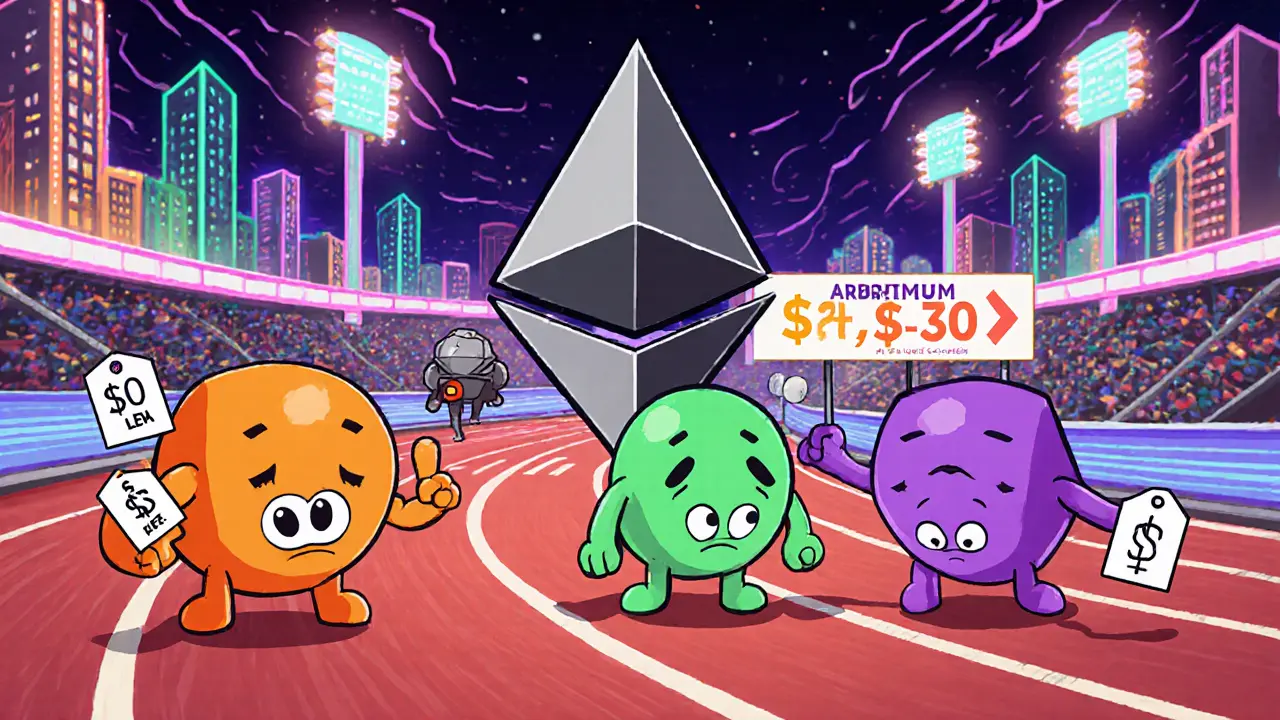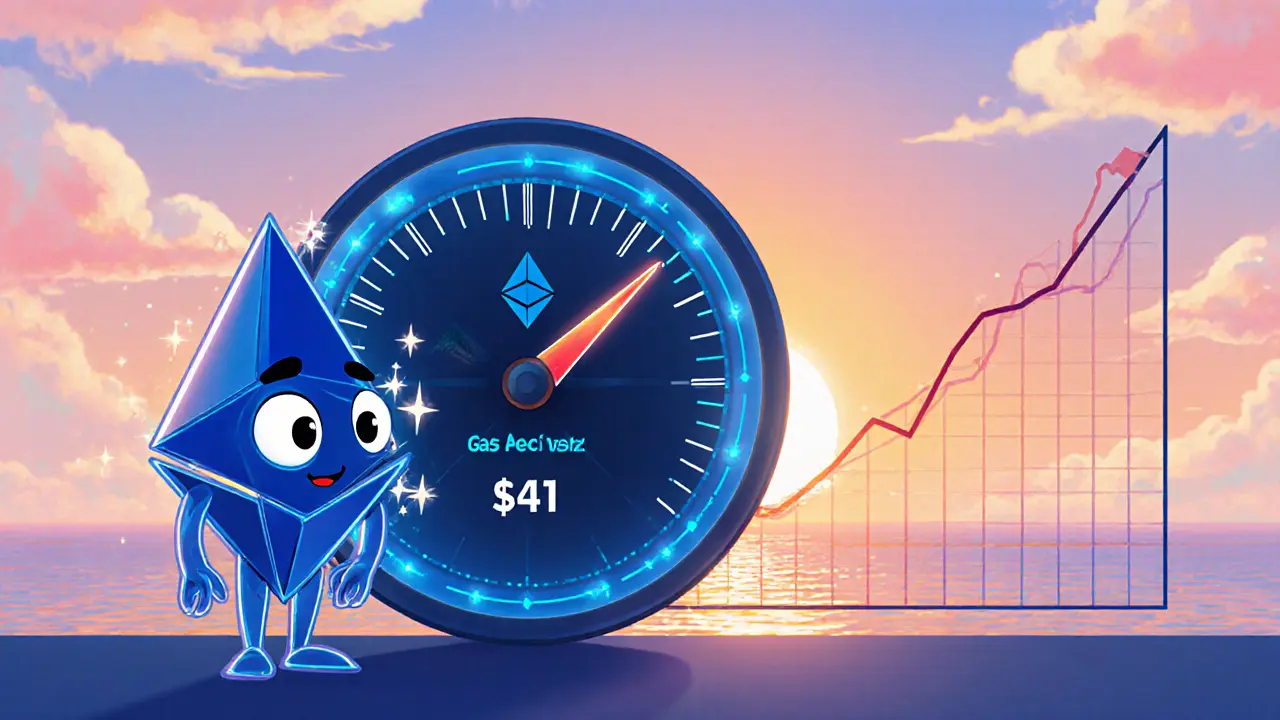Blockchain Fee Comparison Tool
Calculate Your Transaction Costs
See estimated fees for different blockchain platforms based on current data.
Key Takeaways
- Ethereum’s average transaction fee fell to $0.41 in February 2025 after the Dencun upgrade, a 94% drop from 2024.
- Layer‑2 networks such as Arbitrum, Optimism and Polygon now charge 90‑99% less than main‑net Ethereum.
- Solana remains cheaper on a per‑transaction basis, but its cost advantage narrows when network congestion spikes.
- Timing your transactions for off‑peak hours can shave another 25‑40% off fees across most platforms.
- Using gas‑tracker tools and setting custom gas limits in wallets like MetaMask is essential for consistent savings.
What Ethereum gas fees Actually Are
Ethereum is a programmable, proof‑of‑stake blockchain that runs smart contracts and decentralized applications. Every action on the network - sending ETH, swapping tokens, minting an NFT - consumes computational work measured in gas. Gas is priced in gwei (1 gwei = 0.000000001 ETH) and the total fee follows the EIP‑1559 formula:
(Base fee + Priority fee) × Gas limit = Total transaction fee
The base fee is automatically burned and adjusts to network congestion, while the priority fee (a tip) incentivizes validators to prioritize the transaction. A simple ETH transfer uses 21,000 gas units. At a gas price of 20 gwei, the fee equals 21,000 × 20 = 420,000 gwei, or 0.00042 ETH.
2025 Gas Landscape: Numbers That Matter
After the Dencun upgrade, average gas prices settled around 2.7 gwei - down from 72 gwei a year earlier. That translates to an average fee of roughly $0.41 per transaction, the lowest point in four years. Here are a few concrete snapshots:
- Simple token swap: $86 in early 2024 → $0.39 in February 2025.
- NFT mint: $145 → $0.65.
- Daily network‑wide gas spend: $23 million peak → $7.5 million (70% reduction).
Even with these averages, fees can spike during high‑demand events - a $50 swap on February 19 2025 showed that volatility is still real.

Layer‑2 Solutions: The Biggest Fee Cutters
Layer‑2 networks settle transactions off‑chain and then roll them up to Ethereum, dramatically easing congestion. The most popular options in 2025 are:
- Arbitrum is an Optimistic Rollup that inherits Ethereum’s security while offering cheaper, faster settlement.
- Optimism is another Optimistic Rollup focusing on developer‑friendly tooling and near‑instant finality.
- Polygon is a hybrid solution that combines Plasma, sidechains, and rollups for ultra‑low fees.
Across these three, users typically pay $0.01‑$0.03 for the same actions that would cost $0.30‑$0.40 on Ethereum main‑net. That’s a 90‑99% reduction.
How Ethereum Stacks Up Against Other Blockchains
When you compare raw transaction costs, the picture looks like this (average fees from February 2025 data):
| Platform | Simple ETH/Token Transfer | DeFi Swap | NFT Mint |
|---|---|---|---|
| Ethereum (main‑net) | $0.41 | $0.39 | $0.65 |
| Arbitrum (L2) | $0.02 | $0.01 | $0.02 |
| Optimism (L2) | $0.02 | $0.01 | $0.02 |
| Polygon (L2) | $0.01 | $0.01 | $0.02 |
| Solana is a high‑throughput, proof‑of‑history blockchain known for low fees | $0.0005 | $0.001 | $0.002 |
| Binance Smart Chain | $0.03 | $0.04 | $0.05 |
Solana still offers the lowest absolute fees, but its advantage shrinks when the network is busy - fees can climb to $0.01‑$0.02 per transaction. Meanwhile, Ethereum’s Layer‑2 options give you Ethereum security with costs comparable to Solana.
Practical Tips to Keep Fees Low
- Pick off‑peak windows. Data from MEXC and KuCoin shows 25‑40% savings from midnight to early morning UTC.
- Use a gas‑tracker. Websites like Etherscan’s Gas Tracker or the built‑in MetaMask estimator let you see real‑time base fees.
- Set custom gas limits. For simple transfers, 21,000 units are enough. Raising the limit unnecessarily adds cost.
- Route through Layer‑2. Most DeFi platforms (Uniswap v4, Aave) now have direct L2 bridges; use them instead of main‑net swaps.
- Leverage batch transactions. If you need to move multiple tokens, aggregators can bundle them into a single on‑chain call, cutting total gas.
New users typically need 15‑30 minutes to grasp these basics, but mastering timing strategies can take weeks of experience. Community Discords and Telegram groups often post “fee alerts” that help you jump on cheap windows.
Why the Fee Drop Matters for Adoption
Lower costs unlock use cases that were previously uneconomic:
- Micro‑payments for content (tips under $0.05) become viable.
- High‑frequency trading bots can operate without eroding profit margins.
- Enterprise supply‑chain solutions on Ethereum now face lower operational overhead.
Analysts from KuCoin note that DeFi volume on Ethereum grew by 18% YoY in Q1 2025, a trend they attribute largely to the fee collapse.
Future Outlook: Will Fees Stay Low?
The Ethereum Foundation’s roadmap includes further scaling upgrades (e.g., Danksharding) slated for late‑2025. If those rollouts stay on schedule, base‑layer fees could dip below $0.20 on average. Meanwhile, Layer‑2 ecosystems keep innovating - zk‑Rollups promise sub‑cent fees with added privacy.
Nevertheless, occasional spikes will persist whenever demand outpaces capacity. Keeping an eye on network health indicators (pending transaction count, base fee trend) remains the best defense.
Frequently Asked Questions
How is an Ethereum gas fee calculated?
The fee equals (Base fee + Priority fee) multiplied by the Gas limit. The Base fee adjusts automatically with congestion, while the Priority fee is a tip you set for faster processing.
Are Layer‑2 fees always cheaper than Ethereum main‑net?
In 2025, yes - most L2s charge 90‑99% less for the same transaction types because they process off‑chain and only submit compressed proofs to Ethereum.
Why does Solana sometimes become more expensive?
Solana’s fees are ultra‑low, but the network can become congested during popular NFT drops or DeFi launches, pushing the per‑transaction cost up to $0.01‑$0.02, which is still cheap but narrows the gap with Ethereum L2s.
What tools can help me monitor gas prices?
Etherscan Gas Tracker, GasNow, and built‑in wallet estimators (MetaMask, Trust Wallet) all display real‑time base fees and suggest optimal gas limits.
Will future Ethereum upgrades eliminate fees entirely?
Fees are a core part of incentivizing validators. Upgrades aim to lower them, not remove them. Expect ongoing reductions, not zero cost.

8 Comments
Ron Murphy
Dencun was a game-changer. 2.7 gwei? I remember paying $15 for a token swap last year. The math doesn't lie - L2s are where the real action is now. Mainnet's basically a museum piece for purists who still think gas wars are a sport.
Arbitrum’s UI has gotten stupidly smooth too. No more guessing if your tx will confirm. Just send and walk away.
Prateek Kumar Mondal
Solana still cheapest but dont trust it when NFT drops hit
Nick Cooney
so you're telling me after 6 years of 'web3 is the future' we finally got to 'just use arbitrum and chill'... congrats capitalism you win again
also i typed 'gwei' wrong in my wallet 3 times this week and still paid. thanks metaMask for not correcting me. i feel seen.
Clarice Coelho Marlière Arruda
i just set my gas limit to 21k and forgot about it... until i tried to swap a token and it failed. then i remembered i need to use a tracker. why is this so hard??
also why does my phone say 'gas fee: $0.01' but my desktop says $0.04? who do i believe?
Brian Collett
Anyone else using ZKSync for NFT mints now? Feels like $0.005 and it's still on Ethereum security. I'm not going back to Polygon after trying this. Also, the UI is way less janky than Optimism. Just saying.
Allison Andrews
It's funny how we treat gas fees like a moral issue. We celebrate the drop as 'freedom' but ignore that it's just market efficiency. The system still extracts value - it just does it more quietly now. We're not free from cost, we're just better at hiding it from ourselves.
Also, if fees were truly zero, who validates? The energy isn't gone. It's just outsourced to incentives we don't see.
Wayne Overton
L2s are just a bandaid. Solana will eat this alive when it fixes its downtime.
Alisa Rosner
OMG YES!!! 😍 I just started using Etherscan's gas tracker and it's like having a personal assistant 🙌 I set alerts for when fees drop below 3 gwei and now I only transact at 3am. My wallet thanks me 💸 Also, if you're new - DO NOT set gas limit higher than needed! I once paid $2 for a $0.10 transfer... rookie mistake 😅